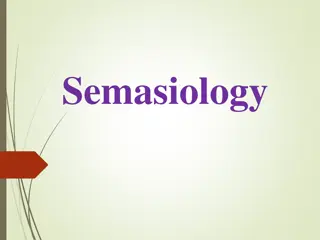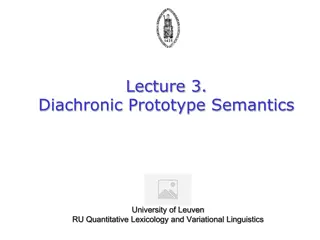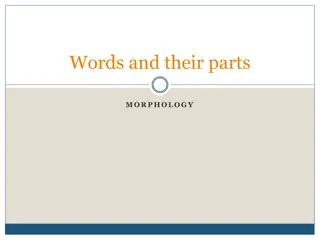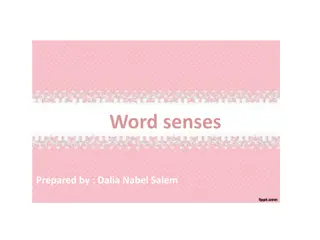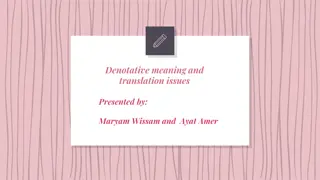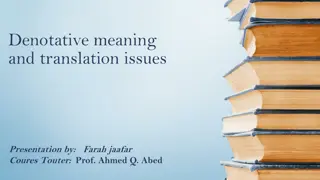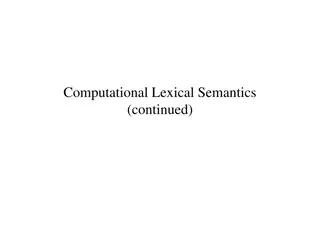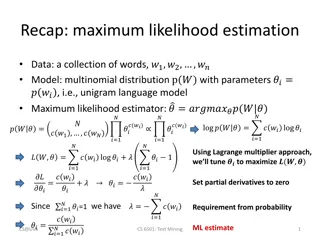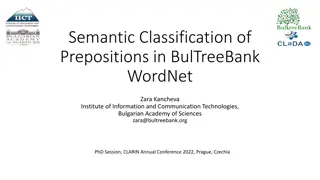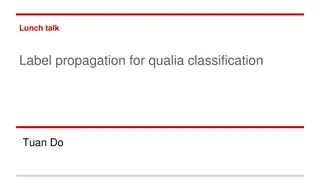Lexical Semantics
Delve into the intricacies of word meanings, from basic definitions like lexeme and lexicon to possible word relations such as homonymy, polysemy, synonymy, and more. Understand how words combine to form sentences and how their meanings contribute to discourse analysis.
0 views • 46 slides
Understanding Semasiology: The Study of Word Meaning
Semasiology is a branch of linguistics focused on the meaning of words. It delves into various aspects of lexical meaning, semantic development, polysemy, and semantic structure. Through exploring types of word meanings and semantic changes, semasiology helps us comprehend the intricate nuances of l
4 views • 19 slides
Understanding Semasiology: The Study of Meaning in Language
Semasiology, a branch of lexicology, focuses on the study of meaning in language through different approaches such as the referent approach and functional approach. The referent approach links the sound form with the concept denoted by the word, while the functional approach emphasizes the relations
2 views • 15 slides
Evolution of Lexical Categories: A Cognitive Sociolinguistics Perspective
The lecture series at the University of Leuven explores Diachronic Prototype Semantics and its implications for Variational Linguistics. It delves into semasiological, conceptual onomasiological, and formal onomasiological variation in linguistic meaning, emphasizing the role of variability in the e
2 views • 67 slides
Understanding Words and Their Parts in Morphology
Explore the world of words and their parts in morphology through exercises, classifications of word classes, differentiation between content words and function words, analysis of words beginning with "b," homonyms, polysemy, and verb inflection. Delve into the various aspects of linguistics to enhan
0 views • 49 slides
Understanding Polysemy and Homonymy in Lexical Ambiguity
In lexical ambiguity, polysemy refers to one word having multiple related senses, while homonymy involves different words that sound the same but have unrelated meanings. Distinguishing between polysemy and homonymy can be challenging, but certain guidelines can help differentiate them based on shar
0 views • 27 slides
Understanding Denotative Meaning and Translation Issues
Denotative meaning in translation poses challenges due to the elastic and indeterminate nature of meaning, especially in dealing with the cognitive or literal sense of words. Polysemy, homonymy, and synonymy contribute to complexities in determining precise denotative meanings. The rigidity and flex
0 views • 40 slides
Exploring Denotative Meaning and Translation Issues
Delve into the intricacies of denotative meaning and its implications in translation. Understand the nuances of polysemy and homonymy, along with the significance of synonymy in defining word meanings. Gain insights into the complexities of determining and translating the literal meanings of words.
0 views • 24 slides
Understanding Word Sense Disambiguation in Computational Lexical Semantics
Word Sense Disambiguation (WSD) is a crucial task in Computational Lexical Semantics, aiming to determine the correct sense of a word in context from a fixed inventory of potential word senses. This process involves various techniques such as supervised machine learning, unsupervised methods, thesau
0 views • 67 slides
Statistical Text Analysis Techniques Overview
The content covers key concepts in statistical text analysis, including maximum likelihood estimation, N-gram language model smoothing, and perplexity calculation. It then delves into Latent Semantic Analysis and the practical application of vector space models, highlighting considerations like syno
0 views • 28 slides
Semantic Classification of Prepositions in Bulgarian WordNet: A Comprehensive Overview
This presentation delves into the semantic classification of prepositions in the BulTreeBank WordNet, focusing on the incorporation of prepositions, closed-class words, and the benefits for neural model building in Bulgarian language processing. The motivation behind the study, challenges posed by p
0 views • 7 slides
Understanding Qualia Structure in GL Theory for Semantic Problem-solving
Explore the Qualia structure in GL theory for semantic problem-solving, focusing on issues like polysemy and metonymy. Discover how label propagation aids in qualia classification, with examples ranging from noun compounds to verb-object relationships. Uncover the complexity of Qualia binding and it
0 views • 26 slides


